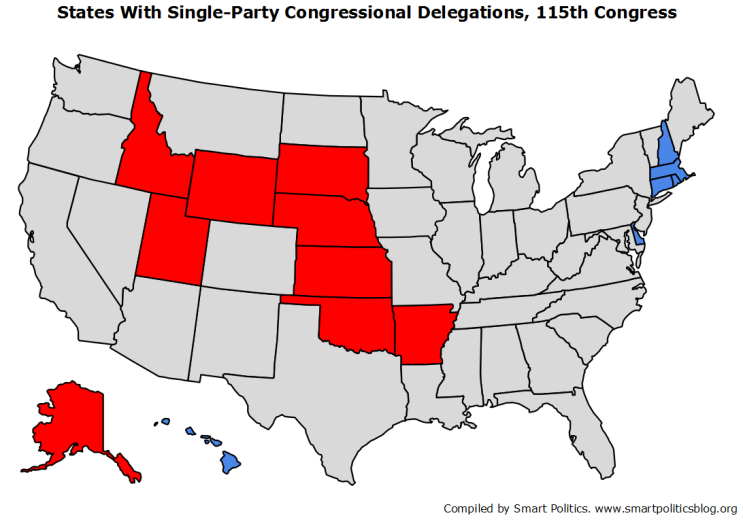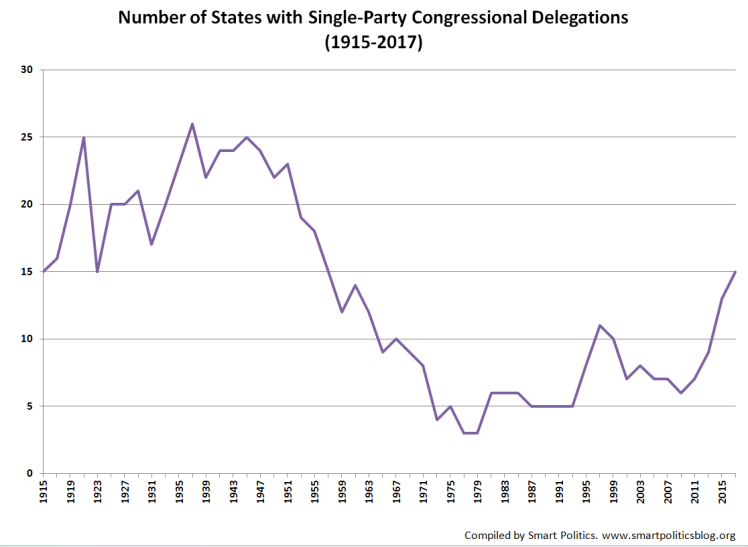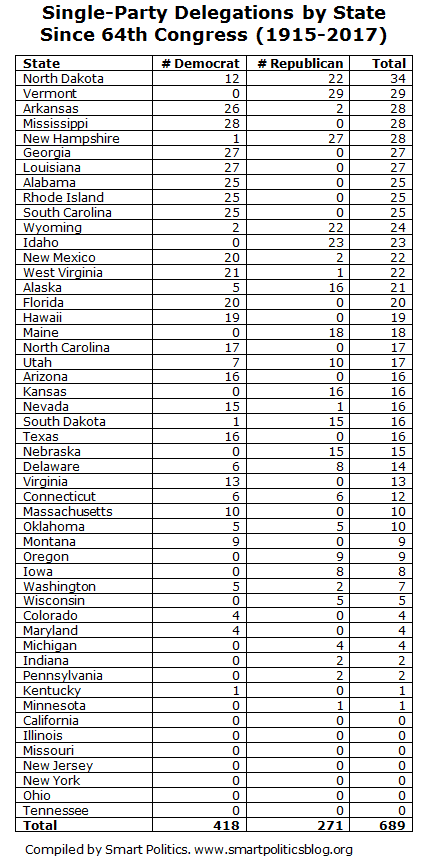115th Congress Has Largest Number of Single-Party State Delegations Since 1950s
Since the passage of the 17th Amendment all but seven states have been represented by a single party in the U.S. House and Senate for at least one Congress

A frequent refrain heard in D.C. is that members on opposite sides of the aisle no longer talk to each other, and thus members are less personally invested in striking deals with the other side.
Compounding the problem is the recent trend of fewer and fewer states being represented by more than one party in Congress – thus providing less opportunities for members to build bipartisan bridges even within a state delegation.
A Smart Politics study finds that 15 states send single-party congressional delegations to the U.S. House and Senate for the 115th Congress – more than double the number from eight years ago and the largest number of such states since the 1950s.
[Note: This study chose the 64th Congress as the departure point as it convened after the first general election in which states began electing U.S. Senators via direct elections (1914). Some states still had U.S. Senators in office who had been elected via state legislatures until the 66th Congress convened in 1919.]
Following the 2016 election, 15 states are now represented by only a single party on Capitol Hill.
Nine states have all-GOP delegations (Alaska, Arkansas, Idaho, Kansas, Nebraska, Oklahoma, South Dakota, Utah, Wyoming) while six are represented by only Democrats (Connecticut, Delaware, Hawaii, Massachusetts, New Hampshire, Rhode Island).
That marks an increase of two states from the 114th Congress when 13 states were represented by one party in both chambers – each of those states listed above minus Nebraska and New Hampshire. [In 2016, the Nebraska GOP ousted Democrat Brad Ashford from the state’s 2nd CD while New Hampshire Democrats unseated Republican incumbents in the U.S. Senate (Kelly Ayotte) and the state’s 1st CD (Frank Guinta)].
By contrast, after the 2008 election there were just six states with single-party representation in Congress: Hawaii, Massachusetts (until Scott Brown won a 2010 U.S. Senate special election), New Mexico, North Dakota, and Rhode Island for the Democrats and Wyoming for the Republicans. That marked the lowest number since 1993 when there were just five single-party states: Hawaii, North Dakota, and West Virginia for the Democrats and Alaska and Wyoming for the GOP.
The number of single-party state delegations increased to seven states in the 112th Congress, nine states in the 113th, 13 states in the 114th, and now 15 states in the 115th.
The last time Congress had 15 states represented by one political party in each chamber was at the convening of the 85th Congress 60 years ago in 1957.
At that time, Democrats controlled all seats in nine states (Alabama, Arkansas, Georgia, Louisiana, Mississippi, Montana, New Mexico, Rhode Island, South Carolina) while the GOP held every seat in six others (Connecticut, Nebraska, New Hampshire, North Dakota, Utah, Vermont).
The nine Republican-controlled states in the 115th Congress is the largest number for the GOP since the 84th Congress (1955-1957) when seats in nine states were all in the Republican column: Iowa, Kansas, Maine, Nebraska, New Hampshire, North Dakota, South Dakota, Utah, and Vermont.
The 15 states represented by one party in D.C. in 2017 is twice the average level seen across the previous 29 election cycles. From the 86th (1959-1961) through the 114th (2015-2017) Congresses, an average of only 7.6 states were represented by just one party.
While this current level of single-party representation in the states is an outlier over the last half-century, it is hardly unprecedented.
From the 64th (1915-1917) through the 85th (1957-1959) Congresses, no fewer than 15 states sent single-party delegations to D.C. with an average of 20.6 states doing so each cycle.
Democrats peaked at 23 states during the 75th Congress after the 1936 landslide while the GOP hit a high water mark during the 67th Congress after lassoing every seat in 17 states after the Election of 1920.
Overall, states have sent single-party delegations to Congress 689 times since the 64th Congress (1915-1917). A total of 418 of these were all-Democratic and 271 were all-Republican.
Nearly every state has sent at least one single-party congressional delegation to D.C. during this 100-plus year span with the only exceptions being California, Illinois, Missouri, New Jersey, New York, Ohio, and Tennessee.
Of the remaining 43 states:
- 14 states have alternately seen their delegations completely controlled by both major parties: Alaska, Arkansas, Connecticut, Delaware, Nevada, New Hampshire, New Mexico, North Dakota, Oklahoma, South Dakota, Utah, Washington, West Virginia, and Wyoming
- 17 states have had only uniform Democratic control: Alabama, Arizona, Colorado, Florida, Georgia, Hawaii, Kentucky, Louisiana, Maryland, Massachusetts, Mississippi, Montana, North Carolina, Rhode Island, South Carolina, Texas, and Virginia
- 12 states have had only uniform Republican control: Idaho, Indiana, Iowa, Kansas, Maine, Michigan, Minnesota, Nebraska, Oregon, Pennsylvania, Vermont, and Wisconsin
North Dakota is the only state to have logged at least 10+ Congresses with its seats under control of Democrats (12 times) and Republicans (22 times).
Of course, Democrats dominated the South for many decades during this span with southern states holding six of the top seven slots for the most cycles with all-Democratic delegations since the 64th Congress: Mississippi (28), Georgia (27), Louisiana (27), and Arkansas (26) claim the top four spots with Alabama (25), South Carolina (25), and Rhode Island (25) tied for #5.
However, many states with moderate to large populations in the Midwest and Northeast saw the Republican Party hold every congressional seat at some point during the last century:
- Pennsylvania: All 38 U.S. House and Senate seats in the 69th (1925-1927) and 71st (1929-1931) Congresses
- Michigan: All 15 seats in the 67th (1921-1923), 70th (1927-1929), 71st (1929-1931), and 72nd (1931-1933) Congresses
- Indiana: All 15 seats in the 66th (1919-1921) and 67th (1921-1923) Congresses
- Iowa: All 13 seats in the 65th (1917-1919), 66th (1919-1921), 67th (1921-1923), 68th (1923-1925), and 69th (1925-1927) Congresses and all 10 seats in the 79th (1945-1947), 80th (1947-1949), and 84th (1955-1957) Congresses
- Wisconsin: All 13 seats in the 65th (1917-1919), 66th (1919-1921), 67th (1921-1923), and 71st (1929-1931) Congresses and all 12 seats in the 80th Congress (1947-1949)
- Minnesota: All 12 seats in the 67th (1921-1923) Congress
- Kansas: All 10 seats in the 67th (1921-1923) Congress
Overall, Vermont has tallied the largest number of cycles with an all-Republican delegation since 1915 with 29 followed by New Hampshire (27), Idaho (23), North Dakota (22), Wyoming (22), and Maine (18).
The last time the GOP held each of the U.S. House and Senate seats with combined delegations of at least 10 seats between the two legislative bodies was in Iowa during the 84th Congress (1955-1957).
Democrats have achieved this feat in Massachusetts (11 seats) since the convening of the 113th Congress in 2013.
Follow Smart Politics on Twitter.




Looking at the states that have never been held by one party, it is obvious that they have large delegations … and there are seven states with only one representative: Alaska, Delaware, Montana, North Dakota, South Dakota, Vermont and Wyoming
Thus, to control the state, it would only take winning three contests (over a four year period when the Senate seats are up), so it is not a surprise that Alaska, Delaware, South Dakota and Wyoming are on the list.
As the number of seats increase, isn’t it logical that there would be more contested seats ?
If anything, it large delegations — Massachusetts (9 seats) and Connecticut / Oklahoma (5 seats) — that defies the odds.
Funny thing is that although these delegations would seem to have more power, how many can claim leadership posts ? Recent history shows the leadership from Wisconsin, Ohio, California, Kentucky, New York, Nevada, Texas, …
What you write about states with large/small populations is generally true, though, as detailed above, there are the occasional large population states that saw one party run the table (e.g. Pennsylvania’s 38 seats in the 69th and 71st Congresses including the 2 US SEN seats). The point here is a relative one – 15 states, given all variables, marks a 6-decade high. So, in short, it has not been a given for most of the low-population states to see one party hold all congressional seats over the last half-century.
If control is defined/determined by membership in a legislative CAUCUS, then the Green Mountain State arguably has had an (uninterrupted) all-D Congressional delegation since June of 2001 (defection of Jim Jeffords); ditto for the Nutmeg State since January of 2009 (defeat of Chris Shays).
Actually, in the 85th Congress, all of West Virginia’s seats were in the Democratic column, not the Republican column as the article states — at least, until Chapman Revercomb was seated in the Senate after his November 1956 election to fill a vacancy.
Thanks for catching that typo, Daniel. The text is corrected above.
On the other hand, if one were to strictly follow the PARTY designation – as opposed to using the memberships of the major party caucuses of HR and Senate – then AK would have 15 rather than “16” all-R delegations (for 2015 and ’16, the state sent 2 clear-cut Rs, along with an independent R who has continued to caucus with her ancestral party; indeed, as of Tuesday the 3rd, 2 days ago, she qualifies as a clear-cut, formal R once again; of course, with a D senator, the 2011-14 is unambiguous, regardless of how she is grouped for that period).
Question: Attention has recently been given that Doug Jones is the first Democrat to win an Alabama Senate seat in 25 years (since Richard Shelby, who has subsequently changed his party affiliation). I live in Kansas – I think we have not elected a Democratic Senator since 1930. What is the longest time that one State has been represented by the same political party with both Senate seats?